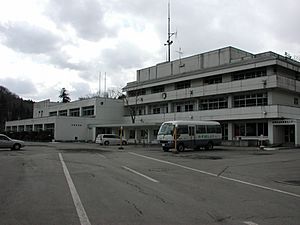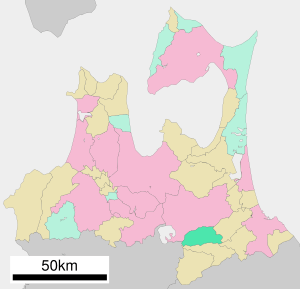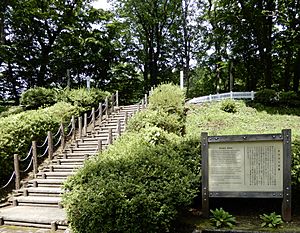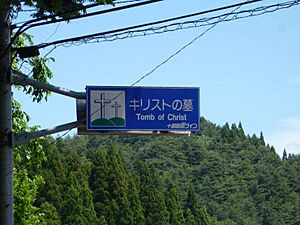Shingō, Aomori facts for kids
Quick facts for kids
Shingō
新郷村
|
|||||||||||
|---|---|---|---|---|---|---|---|---|---|---|---|

Shingō Village Office
|
|||||||||||
|
|||||||||||
 |
|||||||||||
| Country | Japan | ||||||||||
| Region | Tōhoku | ||||||||||
| Prefecture | Aomori | ||||||||||
| District | Sannohe | ||||||||||
| Area | |||||||||||
| • Total | 150.77 km2 (58.21 sq mi) | ||||||||||
| Population
(February 28, 2023)
|
|||||||||||
| • Total | 2,192 | ||||||||||
| • Density | 14.539/km2 (37.655/sq mi) | ||||||||||
| Time zone | UTC+9 (Japan Standard Time) | ||||||||||
| Phone number | 0178-78-2111 | ||||||||||
| Address | 039-0801 | ||||||||||
|
|||||||||||
Shingō (新郷村, Shingō-mura) is a small village in Aomori Prefecture, Japan. As of February 28, 2023, about 2,192 people live here in 895 homes. The village covers an area of about 150.77 square kilometers (58.21 square miles). This means there are about 15 people living in each square kilometer.
Contents
Geography of Shingō
Shingō is located in the southern part of Aomori Prefecture. It is east of Lake Towada. The western side of the village touches Akita Prefecture. Most of Shingō is covered by mountains. These include Mt. Okomagatake, which is 1,144 meters (3,753 feet) high, and Mt. Toraidake, which is 1,159 meters (3,802 feet) high. A main road, National Route 454, goes through the village. It connects Hachinohe in Aomori Prefecture to Lake Towada.
Nearby Towns and Cities
Shingō is surrounded by other towns and cities.
- In Aomori Prefecture:
- From Sannohe District:
- Gonohe
- Nanbu
- Sannohe
- Towada
- From Sannohe District:
- In Akita Prefecture:
- Kazuno
Shingō's Climate
Shingō has a cold climate with four seasons. It has cool, short summers and long, cold winters. There is often a lot of snow in winter. The average temperature for the whole year is about 8.7°C (47.7°F). The village gets about 1,342 millimeters (52.8 inches) of rain each year. September is usually the wettest month. August is the warmest month, with temperatures around 22.2°C (72.0°F). January is the coldest, with temperatures around -3.7°C (25.3°F).
Population Changes in Shingō
The number of people living in Shingō has been going down for the past 70 years. This information comes from official Japanese records.
| Historical population | ||
|---|---|---|
| Year | Pop. | ±% p.a. |
| 1950 | 6,411 | — |
| 1960 | 6,409 | −0.00% |
| 1970 | 4,754 | −2.94% |
| 1980 | 4,332 | −0.93% |
| 1990 | 3,724 | −1.50% |
| 2000 | 3,343 | −1.07% |
| 2010 | 2,851 | −1.58% |
| 2020 | 2,197 | −2.57% |
History of Shingō
During the Edo period (1603-1868), the area around Shingō was controlled by the Nambu clan. They ruled from Morioka Domain. After the Meiji Restoration in 1868, Japan created a new system for its towns and villages. On April 1, 1889, Herai Village and Nozawa Village were formed. Later, on July 29, 1955, part of Nozawa Village joined with Herai. At that time, Herai Village was renamed Shingō.
Education in Shingō
Shingō has schools for younger students. The village government runs one public elementary school, one public middle school, and a preschool. There is no high school in the village.
Shingō's Economy
The economy of Shingō mostly depends on farming. Farmers in the village grow crops like garlic, edible chrysanthemum flowers, and Japanese yam. They also grow tobacco. Shingō has also been known for raising horses for a long time. Today, it is also famous for its cattle farms.
Transportation
No Train Service
Shingō does not have its own train station. The closest train station is JR East Hachinohe Station. You can catch the Tohoku Shinkansen (bullet train) or the Hachinohe Line there. The Aoimori Railway Aoimori Railway Line also serves this station.
Main Highway
 National Route 454 is the main road that goes through Shingō.
National Route 454 is the main road that goes through Shingō.
The "Tomb of Jesus" Legend
Shingō is famous for a unique local story. Some people believe it is the resting place of Jesus Christ. This place is called the "Tomb of Christ" (Kirisuto no haka). The Sawaguchi family in Shingō claims they are descendants of Jesus.
According to this legend, Jesus did not die on the cross in Jerusalem. Instead, his brother, Isukiri, took his place. Jesus then traveled across Siberia to Mutsu Province in northern Japan. Once in Japan, the story says Jesus changed his name to Torai Tora Daitenku and became a garlic farmer. He supposedly married a woman named Miyuko and had three daughters. The oldest daughter married into the Sawaguchi family. People who believe the legend say the Sawaguchi family has some physical features that are not typically Japanese, which they see as proof.
The legend claims that Jesus lived to be over 100 years old. After he died, he was buried in one of two grave mounds in the village. The other mound is said to hold a piece of Isukiri (Jesus' brother) and a lock of hair from Jesus' mother.
Most experts and scholars do not believe this legend. Many of the details come from old papers called the Takenouchi documents (竹内文書, Takenouchi no Sukune). Most scholars think these documents are a hoax (a fake). These papers also claimed that Jesus studied Buddhism in Japan when he was young. They said his teachings in the New Testament came from old Buddhist ideas. These documents were reportedly destroyed during World War II, so no one can check if they were real. Some people think the story might have started with Jesuit missionaries in the 1600s. When Christianity was banned in Japan, these missionaries and Japanese Catholics had to hide.
Today, a Christian church at the "Tomb of Christ" site in Shingō has been turned into a museum. It is called the Legend of Christ Museum. Visitors can enter for a small fee of ¥100. The museum shows displays and items that explain the legend and what daily life was like in Shingō long ago. The museum suggests that some special customs of the village, like drawing a cross on babies' foreheads (a custom that is now lost), came directly from Jesus' teachings.
Every year, a festival (matsuri) is held at the site on the first Sunday of June. Thousands of visitors and people who believe the legend come to Shingō each year. This makes the "Tomb of Jesus" site the main reason tourists visit this small village.
See also
 In Spanish: Shingō (Aomori) para niños
In Spanish: Shingō (Aomori) para niños






